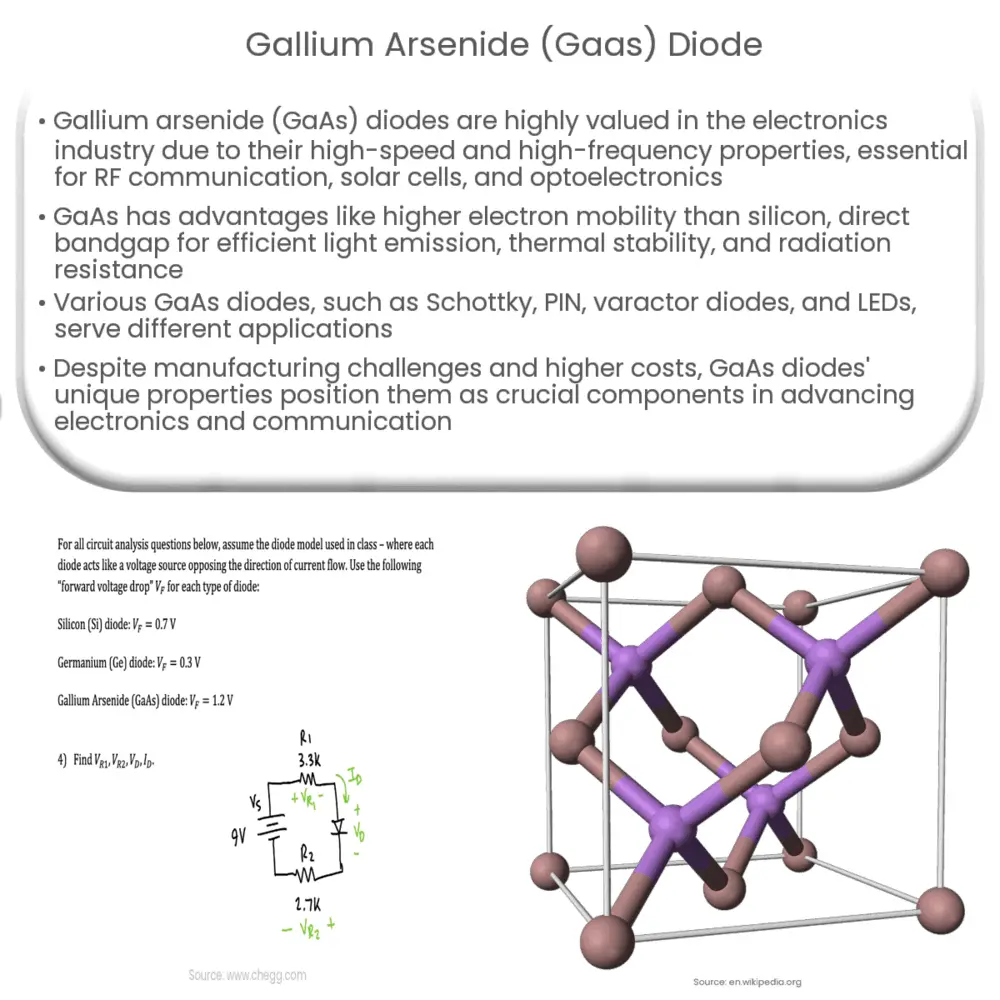Gallium arsenide (GaAs) diodes are high-speed, high-frequency semiconductors used in communication systems, solar cells, and optoelectronics.

Gallium Arsenide (GaAs) Diodes: A Comprehensive Overview
Introduction
Gallium arsenide (GaAs) is a compound semiconductor material that has gained significant attention in the electronics industry due to its unique properties. GaAs diodes are known for their high-speed and high-frequency performance, making them a popular choice for a variety of applications, such as radio frequency (RF) communication systems, solar cells, and optoelectronic devices. This article aims to provide a comprehensive overview of GaAs diodes, their characteristics, and their applications in modern technology.
Properties and Advantages of GaAs
GaAs is a III-V compound semiconductor, which is formed by combining elements from the III (gallium) and V (arsenic) groups of the periodic table. GaAs has several properties that make it an attractive material for use in diodes and other electronic devices. Some of these properties include:
- High electron mobility: GaAs has a higher electron mobility than silicon, allowing for faster operation of electronic devices, such as diodes and transistors.
- Direct bandgap: GaAs has a direct bandgap, which enables efficient light emission in optoelectronic devices, such as light-emitting diodes (LEDs) and laser diodes.
- Thermal stability: GaAs is more thermally stable than silicon, making it suitable for high-temperature applications.
- Radiation resistance: GaAs devices exhibit better radiation resistance than silicon-based devices, making them suitable for space and military applications.
Types of GaAs Diodes
There are several types of GaAs diodes, each with its unique characteristics and applications. Some of the most common GaAs diodes include:
- Schottky diodes: GaAs Schottky diodes have a metal-semiconductor junction and are known for their high switching speeds and low forward voltage drop. They are commonly used in high-frequency applications, such as mixers and detectors in RF communication systems.
- PIN diodes: GaAs PIN diodes have a layer of intrinsic (undoped) semiconductor material sandwiched between p-type and n-type layers. They exhibit low capacitance and high carrier lifetime, making them ideal for high-speed switching and RF applications.
- Varactor diodes: GaAs varactor diodes are voltage-controlled capacitors that can be used to tune the frequency of electronic circuits. They are widely used in voltage-controlled oscillators (VCOs) and phase-locked loops (PLLs) for communication systems.
- Light-emitting diodes (LEDs): GaAs LEDs emit light when an electric current passes through the diode. They are used in infrared communication systems, optical fiber communication systems, and various display technologies.
GaAs Solar Cells
GaAs solar cells have emerged as a promising alternative to traditional silicon-based solar cells, owing to their superior conversion efficiency and radiation resistance. The direct bandgap of GaAs allows for efficient light absorption, resulting in higher conversion efficiency. Additionally, GaAs solar cells exhibit excellent performance under concentrated sunlight, making them suitable for concentrator photovoltaic (CPV) systems. The primary drawback of GaAs solar cells is their higher manufacturing cost compared to silicon solar cells. However, ongoing research and development efforts aim to reduce the cost and increase the adoption of GaAs solar cells in the renewable energy sector.
Manufacturing and Challenges
GaAs diodes are typically fabricated using epitaxial growth techniques, such as molecular beam epitaxy (MBE) and metal-organic chemical vapor deposition (MOCVD). These techniques allow for precise control of the material’s composition and crystal structure, resulting in high-quality GaAs layers. However, the manufacturing process for GaAs devices is generally more complex and expensive than that of silicon-based devices, which has limited their widespread adoption.
One of the main challenges in GaAs diode manufacturing is the handling of arsenic, a toxic and hazardous material. Strict safety protocols and environmental regulations must be followed to minimize the risk of exposure and contamination. Additionally, the relatively high cost of GaAs wafers compared to silicon wafers has limited the widespread adoption of GaAs diodes in some applications. Nevertheless, the performance advantages of GaAs diodes continue to drive research and development efforts to overcome these challenges and further expand their applications.
Future Perspectives and Applications
The unique properties of GaAs diodes make them well-suited for a variety of advanced applications in electronics, communication systems, and renewable energy. Some promising future applications of GaAs diodes include:
- 5G and beyond: The high-speed and high-frequency capabilities of GaAs diodes make them ideal for next-generation wireless communication technologies, such as 5G and beyond.
- Terahertz electronics: GaAs diodes are being investigated for their potential in terahertz (THz) electronics, which could revolutionize various fields, including imaging, sensing, and wireless communication.
- Flexible electronics: GaAs diodes can be fabricated on flexible substrates, enabling the development of flexible and wearable electronic devices.
- Quantum technologies: GaAs-based quantum devices, such as single-photon sources and quantum dot lasers, are being explored for their potential in quantum communication and computing.
In conclusion, GaAs diodes offer numerous advantages over their silicon counterparts in terms of speed, frequency, and thermal stability. Despite the challenges associated with their manufacturing and cost, GaAs diodes are expected to play a crucial role in advancing various fields of technology and shaping the future of electronics and communication systems.

